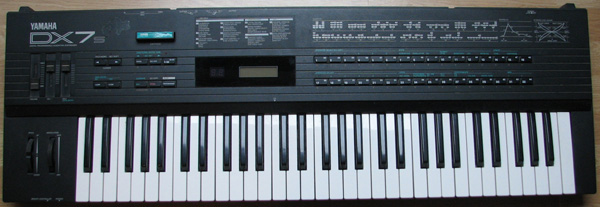Yamaha DX7

Yamaha DX7
Yamaha DX7 Overview:
The Yamaha DX7 is a famous digital synthesizer that was manufactured from 1983 to 1986. The DX7 turned the world of sound synthesis upside-down: Whereas prior to its arrival, most of the synths available were analog - meaning that they used analog circuits and voltages to generate and manipulate tones, the DX7 used a complex form of synthesis called FM - frequency modulation.
The sonic "character" of the DX7 was startlingly different to that of synths that had gone before: Bright, edgy, sparkling sounds and metallic textures were its forte. A couple of its famous sounds were the "DX7 Rhodes" - an electric piano emulation, and an FM guitar sound that sounded surprisingly real, clean and bright.
The DX7 came with MIDI, and was one of the first synthesizers to do so. The DX7 was also different in that instead of being programmed with knobs and switches like the analog synths before it, it was programmed using membrane buttons, a data slider and a diminutive LCD screen. This made the DX7 less intuitive to operate and less capable of realtime sound manipulation. Also, gone were the filters of the analog synth models.
Although Yamaha achieved enormous success with the DX7, it being one of the most popular synths of all time, FM synthesis proved to be too complex and mathematical for users to program effectively. The DX7 could be used to create some fantastic original sounds, but unlike analog synths, which could be manipulated somewhat predictably in a "hands on" fashion, to program the DX7 properly required forethought and even actual mathematical calculation.
Perhaps in an effort to assist would-be DX7 programmers, Yamaha published a book on FM synthesis in 1987, written by none other than the inventor of FM synthesis, John Chowning himself: Fm Theory and Applications: By Musicians for Musicians.
Unfortunately, this book may have had the oppposite effect - of alienating many users: The book shows FM synthesis to be spectacularly complex and simply beyond the majority of synthesizer users - who for the most part would rather get their hands on an instrument and play than study complex mathematical algorithms. Chowning's book is now uncommon and is commonly priced over $50 used on Amazon.
The world of synthesizers never stays the same for long. It wasn't long before the next generation of "sample and synthesize" machines, which were also digital but featured a read-only set of digital samples as their base tonal pallette, took over in popularity. By the 1990's, the majority of interest was in samplers, ROM-based machines and a revival of the old analog sound. Yamaha released one final "monster" FM synth in the late '90's, the FS1R - but despite being a phenomenal machine, did not sell well due to the lack of "instant gratification appeal" and ease of programmability which users had become accustomed to.
Note - Yamaha has recently (2007) released the DX200, a hybrid FM / "groovebox" style desktop machine with sequencer, FM sounds, sampled drums, knobs and filters!
More Yamaha DX7 pics:

Yamaha DX7s
(image - Speculos under GNU Free Documentation license 1.2)
THe DX7 "Family":
Yamaha released a number of "DX7 variants" ,including:
• The DX7 IID, released in 1987 (upgraded the sound quality from 12 to 16 bit, allowed "keyboard split" sounds, increased the number of
voices to 64, and was stereo);
• the DX7s, which had improved sound quality and a few other updates;
• the TX802, which was a rackmounted version of the DX7II;
• the DX11 (4 FM operators, multitimbral);
• the TX81Z half-space 1U rack model of the DX11;
• the DX9 (cheaper than a DX7 and 4 FM operators insead of 6);
• the DX1 ("flagship" - dual 6-operator FM synth engines, 73-note weighted keyboard, display screens, only 140 ever made);
• the DX5 (same as DX1 inside, dual 6-operator FM synth engines, 76-note keyboard);
• and the TX816 which was 8 DX7's in a rack with individual MIDI ports and outputs.
Yamaha DX7 Reviews:
DX7 User Reviews on Sonicstate.com
Yamaha DX7 Sounds:
Dave Benson's DX7 Page tons of sounds linked from
here.
Rec'Up's DX7 Soundbanks
Yamaha DX7 Resources and other links:
Yamaha Musical Instruments Official
Dave Benson's DX7 Page - *huge* amount of info here
including internal diagnostics, sounds, tech info, etc etc - amazing resource.
Yamaha DX7 Manuals:
FM Synthesis Tutorial:
F.M. Synthesis - T. Yahaya Abdullah's FM tutorial
Yamaha DX7 Videos:
Retrosound's DX7 II FD sound demo
DX7 demo with "80's style" sounds and progressions
Jazz playing on the DX7



